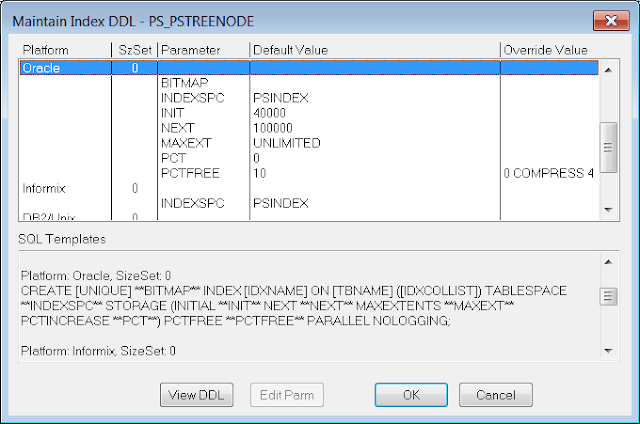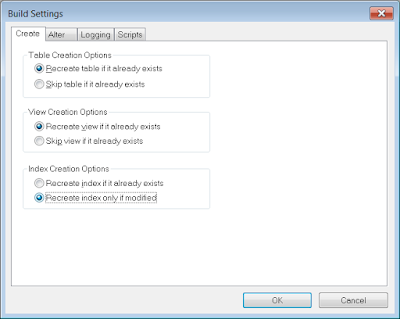One particular technique that I will take as an example for this article is index compression. A good example in PeopleSoft is the tree node table, PSTREENODE. It drives many security and hierarchical queries. It is not updated very frequently, only as new trees are brought on. Many of the indexes are good candidates for compression.
This compression works by storing repeated column values only one per index leaf block. Each distinct set of values in the columns up to the prefix length are stored in a symbol table. The choice of prefix length can significantly affect compression. Oracle can calculate the optimal prefix length using
ANALYZE INDEX … VALIDATE STRUCTURE Optimal
Compression Weighted
Prefix Current Average
Table Name Index Name Length FREQ PARTS Blocks Saving %
------------------ ------------------ ----------- ---- ----- ---------- --------
PSTREENODE PSAPSTREENODE 4 1 0 280 39.0
PSBPSTREENODE 3 1 0 264 30.0
PSCPSTREENODE 1 1 0 120 7.0
PSDPSTREENODE 4 1 0 256 61.0
PSFPSTREENODE 2 1 0 256 67.0
PSGPSTREENODE 3 1 0 400 49.0
PS_PSTREENODE 4 1 0 256 44.0  |
| Figure 1. Index DDL Override |
So, if the build settings (figure 2) are 'recreate index only if modified', which is the default, Application Designer will not generate a DDL script, nor execute any DDL.
 |
| Figure 2. Build Settings |
CREATE UNIQUE INDEX PS_PSTREENODE ON PSTREENODE (SETID,
SETCNTRLVALUE,
TREE_NAME,
EFFDT,
TREE_NODE_NUM,
TREE_NODE,
TREE_BRANCH)
PCTFREE 10 INITRANS 2 MAXTRANS 255 COMPUTE STATISTICS
STORAGE(INITIAL 40960 NEXT 106496 MINEXTENTS 1 MAXEXTENTS 2147483645
PCTINCREASE 0 FREELISTS 1 FREELIST GROUPS 1
BUFFER_POOL DEFAULT FLASH_CACHE DEFAULT CELL_FLASH_CACHE DEFAULT)
TABLESPACE "PSINDEX"
/
ALTER INDEX PS_PSTREENODE NOPARALLEL LOGGING
/
SELECT dbms_metadata.get_ddl('INDEX','PS_PSTREENODE')
FROM dual
DBMS_METADATA.GET_DDL('INDEX','PS_PSTREENODE')
--------------------------------------------------------------------------------
CREATE UNIQUE INDEX "SYSADM"."PS_PSTREENODE" ON "SYSADM"."PSTREENODE" ("SETID"
, "SETCNTRLVALUE", "TREE_NAME", "EFFDT", "TREE_NODE_NUM", "TREE_NODE", "TREE_BRANCH")
PCTFREE 10 INITRANS 2 MAXTRANS 255 COMPUTE STATISTICS
STORAGE(INITIAL 40960 NEXT 106496 MINEXTENTS 1 MAXEXTENTS 2147483645
PCTINCREASE 0 FREELISTS 1 FREELIST GROUPS 1
BUFFER_POOL DEFAULT FLASH_CACHE DEFAULT CELL_FLASH_CACHE DEFAULT)
TABLESPACE "PSINDEX"
DROP INDEX ps_pstreenode
/…
CREATE UNIQUE INDEX PS_PSTREENODE ON PSTREENODE (SETID,
SETCNTRLVALUE,
TREE_NAME,
EFFDT,
TREE_NODE_NUM,
TREE_NODE,
TREE_BRANCH) TABLESPACE PSINDEX STORAGE (INITIAL 40000 NEXT 100000
MAXEXTENTS UNLIMITED PCTINCREASE 0) PCTFREE 0 COMPRESS 4 PARALLEL
NOLOGGING
/
ALTER INDEX PS_PSTREENODE NOPARALLEL LOGGING
/
…
ALTER INDEX PSAPSTREENODE REBUILD TABLESPACE PSINDEX COMPRESS 4;
ALTER INDEX PSBPSTREENODE REBUILD TABLESPACE PSINDEX COMPRESS 3;
ALTER INDEX PSCPSTREENODE REBUILD TABLESPACE PSINDEX COMPRESS 1;
ALTER INDEX PSDPSTREENODE REBUILD TABLESPACE PSINDEX COMPRESS 4;
ALTER INDEX PSFPSTREENODE REBUILD TABLESPACE PSINDEX COMPRESS 2;
ALTER INDEX PSGPSTREENODE REBUILD TABLESPACE PSINDEX COMPRESS 3;
ALTER INDEX PS_PSTREENODE REBUILD TABLESPACE PSINDEX COMPRESS 4;




